As the world awaits the Papal Conclave and election of a new pope I reminisce about the years I lived around the corner from the Vatican and counted St. Peter’s Basilica as my parish church.
When a new pope was chosen the huge bells of St. Peter’s would boom with the joyful news causing a scramble of those living in the neighborhood - for everyone wanted to be in Piazza San Pietro for the “Habemus papa” announcement.
Duomo of Viterbo by Justin Bradshaw
Several extraordinary events happened in the years I lived in the shadow of St. Peter’s dome: the deaths of three popes ( Paul VI, John Paul I and John Paul II), the conclaves that followed as well as the shooting of John Paul II in the Piazza in 1981.
The Vatican/ Borgo Pio neighborhood was always buzzing with brightly robed bishops and cardinals, crowds of pilgrims and clergy filled the narrow streets, the religious souvenir shops and pizzerie surrounding the Vatican from Easter until late autumn.
The Vatican post office, Swiss Guards’ barracks and Museums are essential parts of the neighborhood but it was quite special to enter the Vatican City walls at Sant’Anna gate and spend the morning researching at the Library and Secret Archives. Vatican employees and others with passes could also shop at the Vatican pharmacy, the supermarket and do business at the (in)famous Vatican bank.
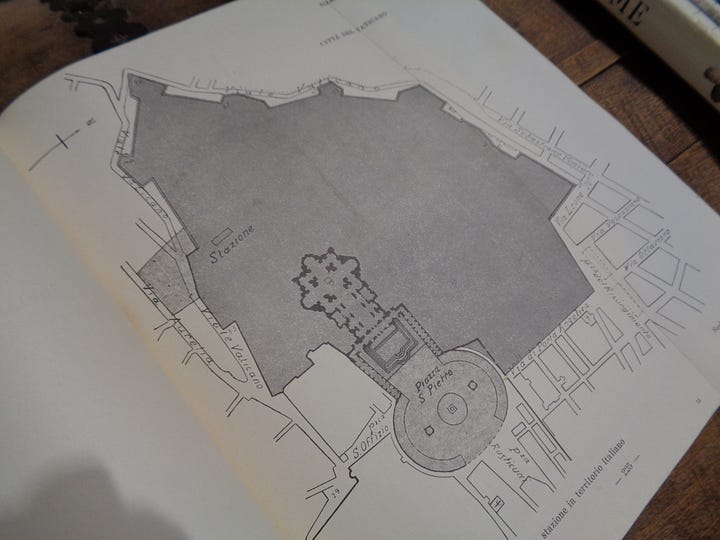
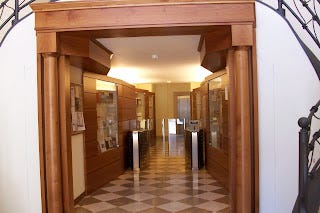
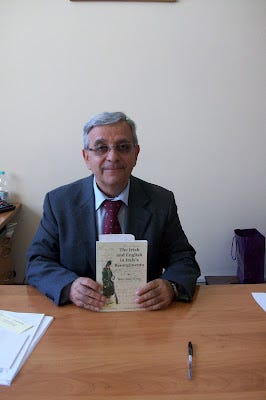

Vatican territory map (1929) , entrance to Vatican library, presentation of my book to the Vatican Library, fountain of the galleon in Vatican Gardens
You will find more articles about the Vatican and Holy Years in the archives of my substack which now counts more than 650 subscribers worldwide. Thank you all for reading, subscribing and spreading the word!
Fast forward half a century and I find myself living near another Papal Palace, located in Viterbo, where the first Papal Conclave lasted for almost 3 years- from 1268 to 1271. Due to unhealthy and dangerous times in Rome the seat of the Papacy had been moved to this quieter -and safer- town and at the death of Clemente IV the cardinals met up in Viterbo to elect his successor. They were not able to come to a decision due to political pressure from their home countries so as the months passed, they ate, drank and were housed at the city’s expense.
Finally Capitano del Popolo, Raniero Gatti, decided to put an end to this free-loading and had the cardinals closed (cum clave=with the key, origin of the word conclave) inside the drafty hall where the election was being held. Gatti then suspended their food and wine and as a last straw the roof was removed, to make it “easier for the Holy Spirit to enlighten” them !
Finally after almost 3 years they decided on Teboldo Visconti, a 61 year old deacon and diplomat who took the name Gregory X. The present conclave still follows some of the rules made to correct the problems encountered in Viterbo.
A few years later, in 1276, the only Portuguese pope was elected in Viterbo. Born in Lisbon in 1215, Pietro Spano became Pope John XXI. He was a scientist and author of Thesaurus Pauperum, ( “treasure of the poor”) a compendium of medieval medicine. He died a year later when an experiment in alchemy went wrong and his studio exploded and collapsed. He is mentioned by Dante in the Divina Commedia as the only pope to have made it to Paradiso.
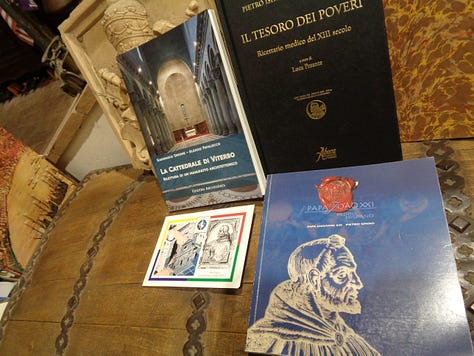
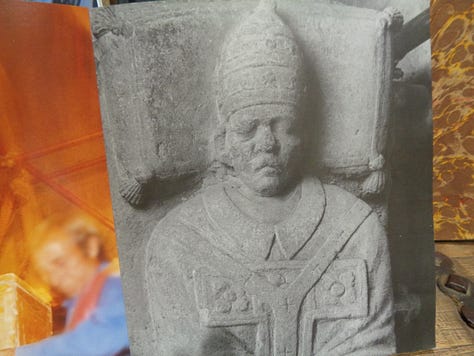
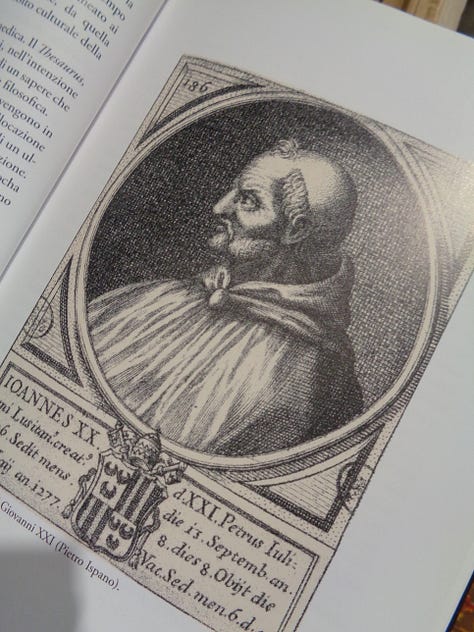
books about the Duomo and Portuguese pope whose tomb was rediscovered in 2000
Below is the interior of the Conclave Hall. Holes in the pavement show where tents were set up after the roof was removed
Things have changed at the Papal Palace of Viterbo since then. After the papal court returned to Rome, the palace and church complex of Viterbo fell into centuries of neglect. Now after 20 years of promotion and museum management by Archeoares, the palace and museum complex enjoys a healthy stream of visitors.
The multi-building site known as Colle del Duomo includes the Museum, Palazzo Papale and separate Palazzo dei Priori/City Hall. The historic happenings come alive during the guided tours organized by the Archeoares group. They now manage museums in nearby towns including Sutri, Tarquinia, Narni, Anagni, Montefiascone and even far away Matera! The Diocesan archives have been collected and conserved in the Papal Palace (see the CEDIDO website) and are a welcoming place for scholars and researchers as well as a venue for conferences year round. Click the link to see some of the many presentations I have given there in the past 15 years .
the Baroque choir hidden in the apse
Besides the Papal Palace, the Conclave Hall, the frescoed Gualterio hall and well stocked Bookshop, visitors can now discover once hidden areas: the Baroque Choir and Sacristy, the Portuguese pope’s tomb and the statue of Napoleon’s scandalous niece - whose story I will narrate in the future.
at the Duomo Bookshop- a shelf full of my books published by Edizioni Archeoares
To discover other stories and secrets of Viterbo - at your own pace - try out the Voicemap audio guide when visiting the city. Click the underlined links to learn more.
Who do you think the new pope will be ? After several foreign-born popes will it be an Italian ? Let’s wait and see, surely this conclave will be much shorter than the first one in Viterbo !
Photos and text copyright © 2013-2025 Mary Jane Cryan- ask permission if you wish to use.





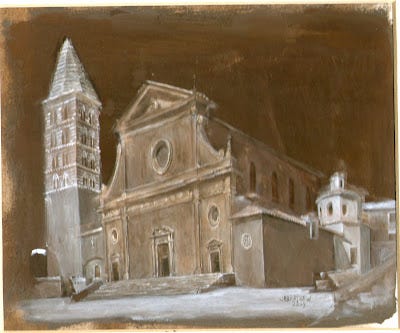
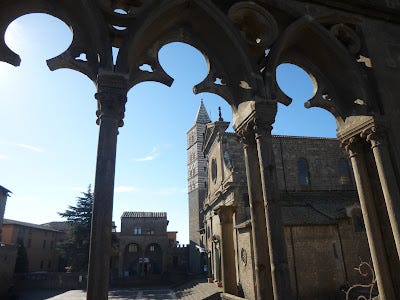

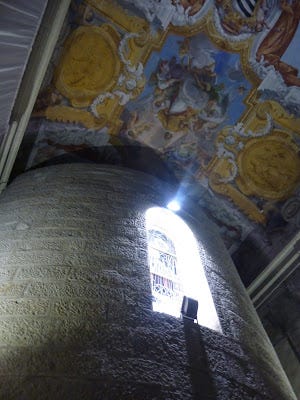


Your anecdotes of history always fill the picture more than the usual history books.
The world's oldest monarchy, the papacy, certainly has lots of them!
Got my "Waiting for a new pope" published just in time ! So surprised and happy at the cardinals' choice- its a very good sign that he is an expat, product of Catholic schools and university, one who knows so many places and lifestyles..with great background and has language proficiency. Leone XIV Benvenuto !